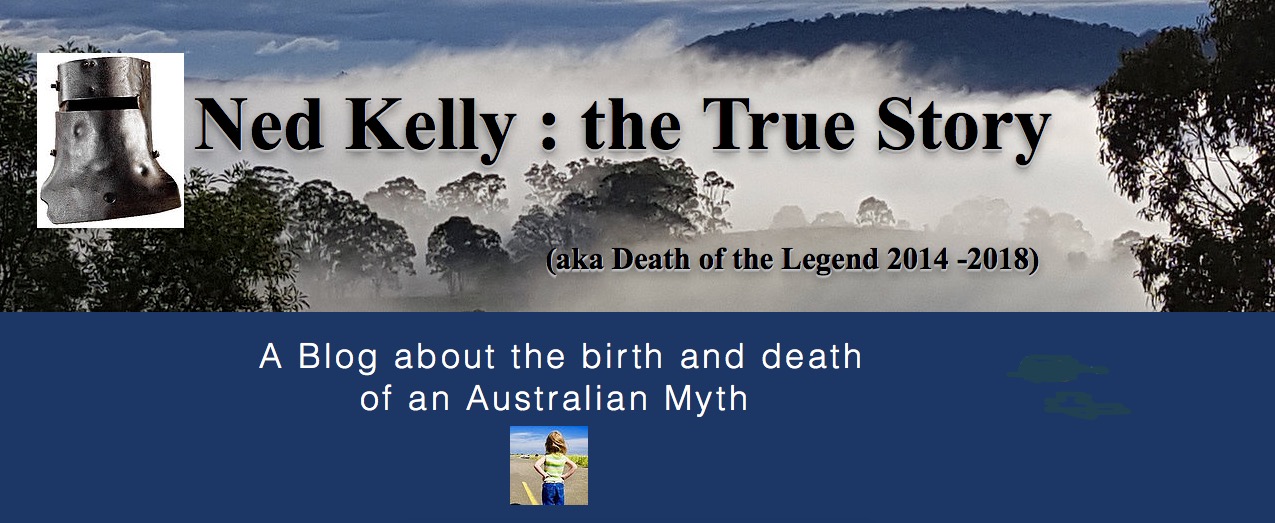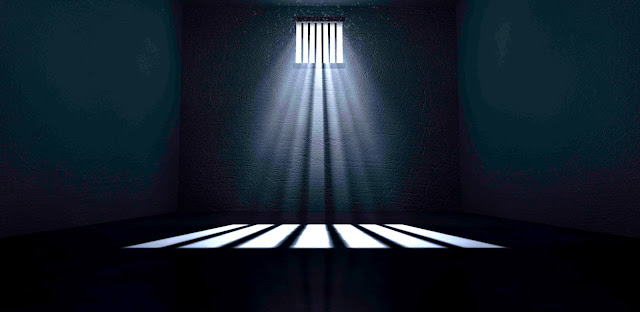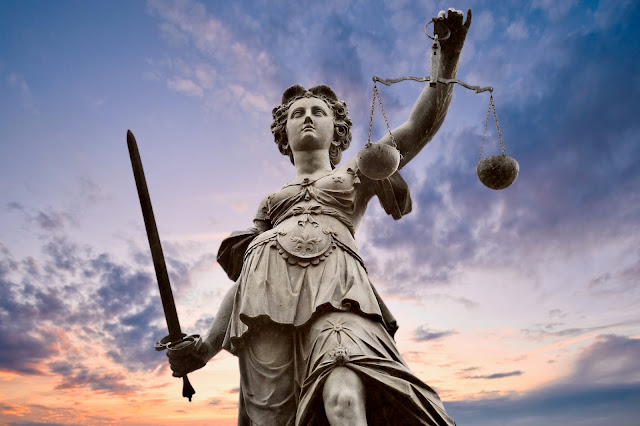 |
| The 2008 Excavation at the site of the Ann Jones Inn at Glenrowan. No cellar was found. The lines of bricks are nothing to do with Ann Jones Inn but are from 20th century buildings long demolished. |
The site of Ned Kellys last
stand, the place where the Ann Jones Inn once stood is for sale. It’s a small
block of privately owned vacant land on Siege Street in Glenrowan and in various
places on the internet and in the press people are discussing what should be
done with it. Some believe it should be left as it is, out of respect for the
lives that were lost there. Others think a replica of the Ann Jones Inn should be built and the site turned into a
tourist destination. The self-confessed Kelly tragic and Wangaratta lawyer who
owns the Kelly-series Nolan painting on display at the Kelly Vault in Beechworth
told the Border Mail that he would like to expose the remains of the Inns
foundations and erect a building with a glass floor over the top of them :
“You have to expose the
foundation made of brick, the burnt stumps that are left and direct people to
where the bodies are found with Father Gibney coming in to give the last rites
for the lads,” Mr Suta said
“You would uncover it, build a
structure, a glass floor, so you could walk over it and place information
boards around it to explain the history.
“When you go overseas to Athens and
Rome, those places, it’s like that, they have archaeological digs exposed and
you walk over them.”
He doesn’t seem to realise that
Adam Fords archaeological investigation of the site in 2008 found that almost
nothing is left of the Ann Jones Inn other than a few post holes. The brick
foundations Suta mentions (seen in the photo above) are nothing to do with the Kelly story - they are the foundations of a ‘wine
shanty’ built in 1910 that later became a Café then a Hair Salon then two flats
that were demolished in 1976. Hardly “Athens and Rome”!
The problem with “Kelly
tragics” in general, when it comes to places like this in the North east of Victoria,
is that they want to turn them into shrines and memorials to a wildly
polarising and completely unhistorical view of Ned Kelly. When they think of
Glenrowan they think of Ned Kellys brave ‘last stand’, they see what happened
there as a sort of tragic destruction of the dreams of a revolutionary hero, brought
down by the great corrupt juggernaut of police and politicians who conspired
against a tiny band of freedom fighters. They blame the Police for the loss of
life there, they think the people held hostage in the Inn by Ned Kelly had a
terrific time until the Police arrived, they think there was a ‘sympathiser
army’ waiting nearby to join the revolution, they venerate the famous symbols of the siege, suits of
home-made armour that the gang wore when they confronted the Police on the veranda
of the Inn and they think if Ned Kellys plan had succeeded it could have resulted
in some sort of positive political and social change. They think it should be
revered like the site of the Eureka rebellion is, but Eureka and Glenrowan have
absolutely nothing in common, except in the minds of Kelly fanatics who don’t understand
history and don’t want to face the facts about Glenrowan.
Not that long ago, those views
of the Kelly outbreak were seen as reasonable, even if many didn’t agree with
them. The narrative put out by the Kelly writers like Brown, Jones Moloney and
McQuilton at the very least suggested such an interpretation of Kelly history
had merits, and it became commonplace for the Kelly story to be presented as a
kind of almost unfathomable conundrum: ‘Ned Kelly – Hero or Villain?’ was the often posed
challenge. I am guessing that in that atmosphere of ambiguity the siege site was
listed by Heritage Victoria.
In the light of more recent
research and thinking into the Kelly story, those romantic notions of a heroic
Ned Kelly have been more or less completely discarded, and replaced by the
historically verifiable view that Ned Kelly was primarily a psychopathic criminal
gang leader. Whereas no evidence has emerged of his involvement in any sort of
political movement or to support the notion that he was a kind of Australian Robin
Hood, much has emerged to show he was a charismatic liar, a forger, a bully, a
thief and of course a multiple Police murderer, whose own writings exposed his
obsessional hatred of authority in general and the Police in particular. Glenrowan,
rather than some sort of Greek tragedy, on examination is revealed as an abysmally
planned and completely bungled plot to carry out terrorist mass murder on a
scale similar to the killings that took place at Port Arthur, a horrifying massacre
that disgusts everyone. It is absolutely certain that had Ned Kelly achieved
what he wanted to at Glenrowan, his memory would be reviled in the same way as the
Port Arthur killer Martin Bryants is, and listed alongside Craig Minogue, Carl
Williams and Julian Knght, the Hoddle Street mass killer. The conundrum is not really whether or not
Kelly was a hero or villain but why there are still a few hundred people in
Australia who noisily and ignorantly promote the memory of a man for whom
murdering three police wasn’t enough. Ned Kelly picked Glenrowan to be the place where he would murder dozens more, and for some unfathomable reason modern Kelly sympathisers and descendants want this to be remembered.
The extent of Ned Kellys
blundering, and the horror of what he planned for Glenrowan needs to be exposed.
Firstly, the day before the planned massacre of police, they murdered Aaron
Sherrit in cold blood. They expected that once he had been murdered in the Woolshed Valley
Police would race up on a train from Melbourne, speed through Glenrowan and
then crash over an embankment where the Gang had ripped up the track. Many
police would die, and any survivors would be killed by the gang wearing armour
they had fashioned over the preceding months - an act of monstrous brutality and violence equal in its time to any act of jihadist terrorism today. They murdered Aaron in the
mistaken belief that this friend and supporter of the gang had betrayed them but
this idea we now know was a figment of the gangs collective paranoia – no evidence
has ever emerged that Aaron ever betrayed the Gang – in fact the consensus nowadays
is that he didn’t and wasn’t ever going to. So, Mistake Number 1 : the ‘champion
of the poor’ killed an innocent man.
The plan relied on the Police quickly
hearing about this murder, but the train didn’t reach Glenrowan until much
later than the Gang had planned, and as a result it all fell apart. But why was it
so late? The answer is mistake number 2 : Joe and Dan, the murderers, hung around Aarons hut for several
hours daring the Police inside to come out, and then after those two left,
sympathisers continued harassing and shouting at them until dawn, which was
when it was finally safe for them to emerge and sound the alarm.
At Glenrowan, in the dark Ned
Kelly and Steve Hart attempted to stealthily rip up the rail tracks : Mistake
number 3 – they hadn’t bought the right tools. Mistake 4 was that they then
destroyed their plan to do this all secretly, by waking up railway workers sleeping
in tents nearby to do it for them. Mistake 5 was that these guys didn’t know
how to do it either so they woke the stationmaster and forced him at gunpoint to
get two platelayers to get the job done. Now the only way to stop news getting out of what the
gang was planning was to take everyone hostage, so they bailed them all up as
the numbers grew in Ann Jones Inn. The whole plan was spiralling into chaos, and the leader hailed since by some as a potential General had no idea what to do. There were a few ‘sympathisers’ posing as
hostages but most were innocent passers-by, including women and children whom
later the gang used as human shields. Letting Curnow go was obviously a
mistake (#6) , as was the decision to engage in a battle with the Police when the Inn
was surrounded and the Gang knew their plan had failed. (#7) And of course the Kelly
Gang armour was a mistake (#8) as well – it was incredibly heavy and cumbersome, the
wearer had little mobility and a greatly reduced field of vision, and as the
Police eventually noticed, it didn’t protect the legs.
Glenrowan wasn’t a heroic last
stand but, from the Kelly gangs perspective it was an absolute debacle that was
entirely of Ned Kellys making. The gang had been surviving in the bush for many
months and could have devised any number of escape plans but even Kelly sympathiser
Ian Jones said the one Ned chose was “madness’. It was triggered by the murder
of an innocent friend and resulted in the death of Neds own brother and two other
gang members, the death of two or perhaps three innocent hostages, and the
capture of its leader. The plan to kill police and perhaps to somehow free Ned
Kellys mother ended with no police killed, Ellen Kelly still in Gaol and her
son joining her, soon to be on death row, and in a matter of weeks hanged. Complete
and utter humiliation.
There were also two other innocent
lives lost at Glenrowan – Johnny Jones and Martin Cherry, killed in the mayhem by Police
bullets. Some criticisms of police behaviour at Glenrowan, as at the Lindt Café
siege are justified – mistakes were made in both sieges but everyone but a few extreme Kelly fanatics
accepts that responsibility for those deaths lies with the individual who deliberately
placed them in harms way : Ned Kelly in 1880, Man Haron Monis in 2014.
The land for sale in Glenrowan
marks the place where the murderous Kelly gang was finally brought to its knees
in a bloody showdown. It’s the site from which the true hero of Glenrowan, brave
Thomas Curnow escaped, stopped the train and saved many innocent lives. In those
respects therefore it is a place that carries a modicum of historical
significance but its not a place that should be remembered for a heroic ‘last
stand’ so much as the place where the Kelly Gang created a calamitous self-inflicted
finale, and the Police bought the Kelly outbreak to an end. It’s a place of death and terror and shame
where the only hero was Thomas Curnow. Why on earth would anyone who knew what really happened there ever want to remember it?
A former Wangaratta Mayor and
Kelly descendant Anthony Griffiths said “from a community perspective and certainly from a family perspective it needs to be treated with the
respect it deserves”
– which raises the question, what IS the respect that it deserves? No doubt as a Kelly descendant he thinks it
should be respected as the site of a brave ‘last stand’, but that would be a
deceit. He has suggested Government should take control of the
land, and John Suta has said he would be seeking Government funding if his
proposal was accepted. If John Suta becomes the new owner and he wants to create
a memorial there, rebuild the Inn, invite tourists in for drinks, and pedal the
unhistorical rubbish that he clings to against all the evidence about Ned Kelly,
it’s a free world and he is entitled to do it, if he is prepared to fund it. However, he and perhaps more importantly the Council when he asks them for money - should take note of
how little interest there has been in the Kelly movie – less than 400 people in
the whole of Australia- he should take note of how Glenrowan has become a
ghost-town since the highway bypassed it, and ask himself why the existing ‘attractions’
are mostly failing and up for sale. The reality is that almost nobody believes the
Kelly myths anymore, and local Councils and Government bodies should not be
supporting them.
In the end, if its privately
owned land, the owner should be able to do whatever he wants to with it. I am
not familiar with how Heritage Listings work but I imagine if something can be
placed on the register it could also be removed from it…and that’s what I think
should probably happen - this is a not a site where anything other than a crime happened, and a far worse one was avoided.
A simple plaque and the famous Ann Jones Inn sign should be enough to mark this infamous place, and if any heroes are mentioned, it should only be Thomas Curnow. There are no memorials to murderers Man Haron Monis, Julian Knight, Craig Minogue or Carl Williams and there shouldn’t be any to Ned Kelly either.
A simple plaque and the famous Ann Jones Inn sign should be enough to mark this infamous place, and if any heroes are mentioned, it should only be Thomas Curnow. There are no memorials to murderers Man Haron Monis, Julian Knight, Craig Minogue or Carl Williams and there shouldn’t be any to Ned Kelly either.


